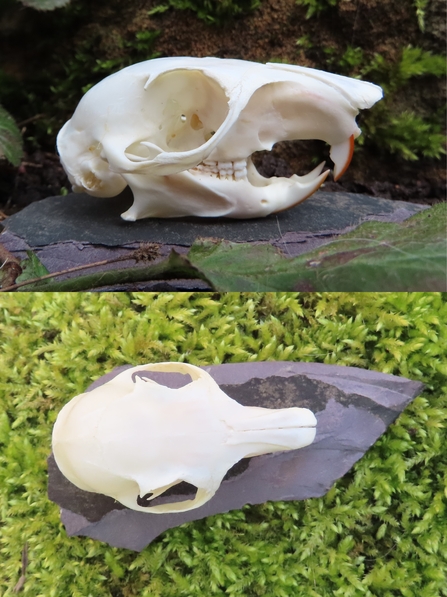78 Animal Skull Identification
The shrew in our area is Trowbridges Shrew. Muntjac deer skulls can be identified by their large suborbital pits - the bones that sit under the eye sockets.

Identify Animal Skulls The Wildlife Trusts
A dichotomous key allows a person through a series of questions to identify an organism to species by process of elimination.
Animal skull identification. All teeth large compared to other rodents of similar size. Students observe the characteristics of the teeth. Animal Skulls has very nice illustrations and pictures of skulls while Skulls and Bones is an excellent source for the functions of the bones.
The iron deposits serve to harden the enamel and are concentrated in those parts of the teeth most subject to wear coyote. I like to see photos of skulls you may have found and will do my best to identify them. Tooth bed is oval shaped not teardrop shaped.
Males have prominent tusks too. If you are unsure of a skulls identification you can compare it with other known specimens. Upper rim of eye socket is rounded does not have a pointed edge.
Animal Skull ID. Skull 40-58mm longLong-tailed weasel Infraorbital foramen Dumbbell-shaped molar Rectangular molar. Animal Bone Identification FRAG_101 2021-01-05T1434160000 This beginners guide to animal bone identification has been written by Chris Faine and is one of a series of introductory guides published by the community archaeology network Jigsaw.
Skull identification can be determined by several methods. H uman Some skulls you may find by order. I just added a post on animal skull ID using teeth and dentition.
A dichotomous key allows a person through a series of questions to identify an organism via the process of elimination. Front molars emerge straight from tooth bed not at an angle. Key to Rodent Skulls Cotton Rat Sigmodon hispidus 1.
The site has gradually expanded to include skulls photographed elsewhere and to cover topics such as identification and preparation although the site retains a vaguely UK-centric focus. Red-tipped teeth you have the skull of a shrew. The most effective means of identifying a skull to species is with the use of a dichotomous key.
These are some really nice books that will aid in skull identification. When examining skulls to determine predators we of course look for the teeth characteristics of a carnivore or an omnivore. Click here to check out the blog post.
Plants fish and even skulls can be identified. This however can be less than accurate and most will not have access to a large collection of known species. There is another skull characteristic that is very useful in determining predatorprey classification.
In this ecology lesson plan students define the terms herbivore omnivore and carnivore and study animal teeth and skulls. Skull characteristics such as eye placement teeth types dentination and jaw structure can help tell us if the animal was a predator or prey. If the teeth characteristics of a skull are strictly those of a herbivore we consider the animal to be a prey species.
Auditory structure in carnivores. Badger skulls are slightly shorter than a foxs at around 13cms long. The most effective means of identifying a skull and determining the correct species is with the use of a dichotomous key.
First when you find a skull or bone and you want to know if its OK to keep you need to be aware of the Federal and state regulations regarding animals. Mammal skulls include beaver black bear bobcat cougar coyote deer fox jack rabbit opossum raccoon skunk and squirrel. Top row shows ventral view of adult bulla middle row shows ventral view of neonatal bulla.
Photo Scott Flemming Flicker Common Use. Although most natural history museums have displays of animal skulls it can often prove difficult to find a quality guide that can help you identify specimens you may come across in the field. Identifying Animal Skulls By Their Teeth Canine skull with clear carnassial and canine teeth Photo.
Plants fish and even skulls can be identified using this method. The skull can be a valuable tool when it comes to identifying a species understanding its anatomy and dietary habits and helping us understand evolution. Fox skulls have long narrow snouts and are around 14cms in length.
Students identify various types of animal skulls and teeth. Elements forming the auditory bulla in left to right a bear arctoid a dog cynoid and a cat feloid. Below is an example of a dichotomous skull key.
Bird skulls include bald eagle barn owl Canada goose cardinal cormorant flamingo great blue heron pheasant pileated woodpecker raven roadrunner and wild turkey. Skull over 58mm longMink 4. Animal Skulls Identification.
Mammals of North America is a great resource to. Molar groove shaped like. Skulls can tell us many things - what the animal ate if it was an herbivore omnivore or a carnivore.
The enamel of the tips of their teeth is reddish due to iron pigment.
